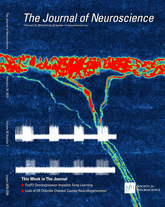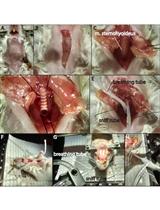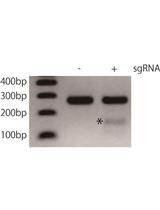- EN - English
- CN - 中文
Mouse Auditory Brainstem Response Testing
小鼠脑干听觉区反应测试
发布: 2016年03月20日第6卷第6期 DOI: 10.21769/BioProtoc.1768 浏览次数: 17947
评审: Oneil G. BhalalaPascal Fossat Anonymous reviewer(s)
Abstract
The auditory brainstem response (ABR) test provides information about the inner ear (cochlea) and the central pathways for hearing. The ABR reflects the electrical responses of both the cochlear ganglion neurons and the nuclei of the central auditory pathway to sound stimulation (Zhou et al., 2006; Burkard et al., 2007). The ABR contains 5 identifiable wave forms, labeled as I-V. Wave I represents the summated response from the spiral ganglion and auditory nerve while waves II-V represent responses from the ascending auditory pathway. The ABR is recorded via electrodes placed on the scalp of an anesthetized animal. ABR thresholds refer to the lowest sound pressure level (SPL) that can generate identifiable electrical response waves.
This protocol describes the process of measuring the ABR of small rodents (mouse, rat, guinea pig, etc.), including anesthetizing the mouse, placing the electrodes on the scalp, recording click and tone burst stimuli and reading the obtained waveforms for ABR threshold values. As technology continues to evolve, ABR will likely provide more qualitative and quantitative information regarding the function of the auditory nerve and brainstem pathways involved in hearing.
Materials and Reagents
- 1 ml insulin syringe (Thermo Fisher Scientific, BD, catalog number: 22-253-260 )
- Precision Glide Needles (30 G x 1/2) (BD, catalog number: 305106 )
- Disposable monopolar needle electrodes for electromyography (Rochester Electro-Medical, catalog number: 016386-0 )
- Ketamine hydrochloride
- Ketaset (Ketamine HCl Injection) (Drugs, catalog number: NDC-0856-2013-01 )
- Henry Schein (100 mg/ml solution) (NSN, catalog number: 304401 )
- Ketaset (Ketamine HCl Injection) (Drugs, catalog number: NDC-0856-2013-01 )
- Xylazine hydrochloride (Sedative and Analgesic solution) (20 mg/ml solution) (LLOYD, AnaSed INJECTION, catalog number: 139-236 )
- Sterile bi-distilled water
- Povidone-iodine 5% (Betadine) antiseptic-Microbicide solution (purchased from any pharmacy)
- Dexamethasone ophthalmic ointment (TobraDex) (Alcon)
- 70% Ethanol (Surface disinfectant)
- Mixture of ketamine hydrochloride and xylazine hydrochloride (see Recipes)
Equipment
- Disposable monopolar needle electrodes for electromyography (Rochester Electro Medical, catalog number: 016386-0)
- Computer with BioSig32 Windows Application Installed
- TDT BioSigIII system (TDT)
- TD speakers (TDT)
- Sound proof chamber (Industrial Acoustics Company, Controlled Acoustical Environment)
- Non-Electric Heating Pad (to maintain animal body temperature during the test) (Braintree Scientific, Deltaphase Isothermal Pad, model: 39DP )
- CONAIR Moist Electric Heating Pad (to maintain animal body temperature during the recovery) (Amazon)
- Rectal Probe for body temperature monitoring (Physitemp Instruments, model: Thermalert TH-5 physitemp )
- Clean empty cages
- Tweezers style 5 (Ted Pella, catalog number: 5665 )
Software
- BioSig32 software (coming with the TDT BioSig III system)
Procedure
文章信息
版权信息
© 2016 The Authors; exclusive licensee Bio-protocol LLC.
如何引用
Readers should cite both the Bio-protocol article and the original research article where this protocol was used:
- Akil, O., Oursler, A. E., Fan, K. and Lustig, L. R. (2016). Mouse Auditory Brainstem Response Testing. Bio-protocol 6(6): e1768. DOI: 10.21769/BioProtoc.1768.
-
Akil, O., Sun, Y., Vijayakumar, S., Zhang, W., Ku, T., Lee, C. K., Jones, S., Grabowski, G. A. and Lustig, L. R. (2015). Spiral ganglion degeneration and hearing loss as a consequence of satellite cell death in saposin B-deficient mice. J Neurosci 35(7): 3263-3275.
分类
神经科学 > 感觉和运动系统
神经科学 > 神经解剖学和神经环路 > 动物模型
您对这篇实验方法有问题吗?
在此处发布您的问题,我们将邀请本文作者来回答。同时,我们会将您的问题发布到Bio-protocol Exchange,以便寻求社区成员的帮助。
Share
Bluesky
X
Copy link















